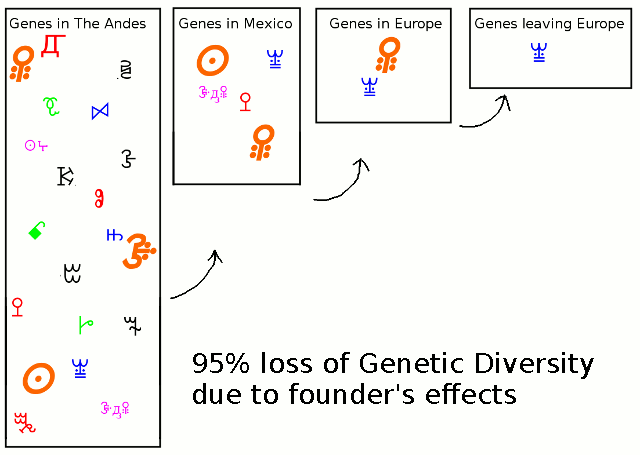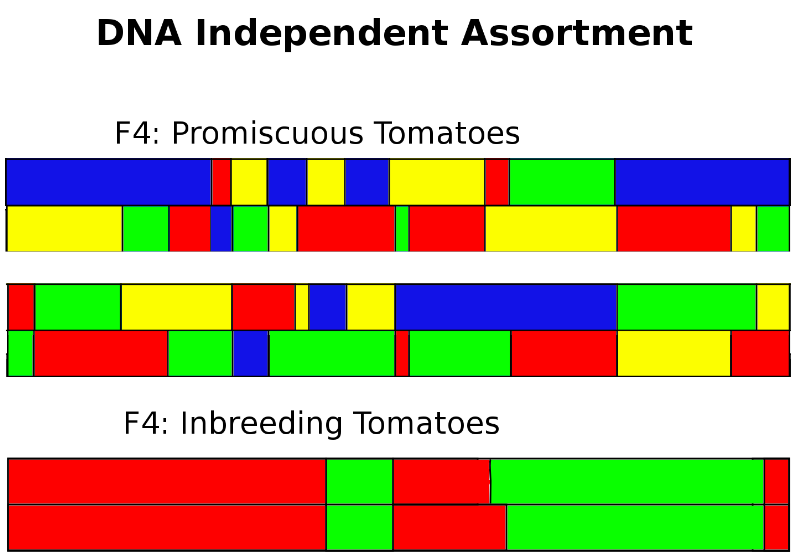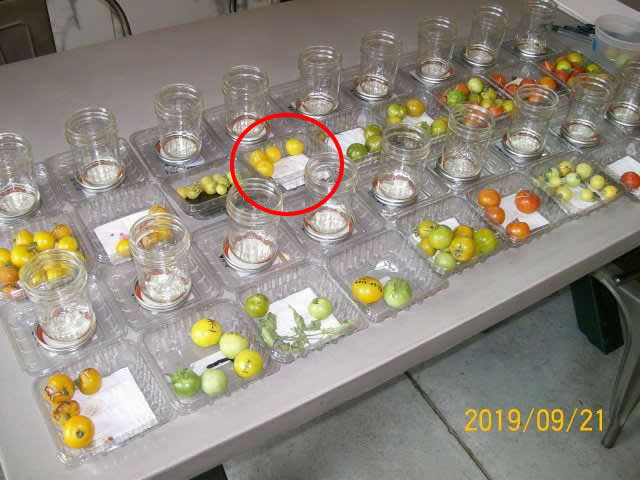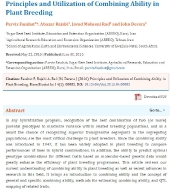




William Schlegel wrote:Discovered that in the patch from my home saved half habrochaites seed the ripe fruit is way down in there.
Found a pretty one in there. The inflorescence they were on had mostly aborted so probably an intact S allele.
Western Montana gardener and botanist in zone 6a according to 2012 zone update.
Gardening on lakebed sediments with 7 inch silty clay loam topsoil, 7 inch clay accumulation layer underneath, have added sand in places.








Western Montana gardener and botanist in zone 6a according to 2012 zone update.
Gardening on lakebed sediments with 7 inch silty clay loam topsoil, 7 inch clay accumulation layer underneath, have added sand in places.





William Schlegel wrote:Joseph, I am really excited about the F2 of Big Hill x W4. I'm thinking about skipping a year on many other things to give the F2 growout a lot of space. Maybe 3 steps apart ~ 9 ft or perhaps 4 steps 12 ft? Figure I should be able to grow ~300 plants from the seed I saved.
Does that sound like a good plan?




Western Montana gardener and botanist in zone 6a according to 2012 zone update.
Gardening on lakebed sediments with 7 inch silty clay loam topsoil, 7 inch clay accumulation layer underneath, have added sand in places.

 1
1






 2
2




Western Montana gardener and botanist in zone 6a according to 2012 zone update.
Gardening on lakebed sediments with 7 inch silty clay loam topsoil, 7 inch clay accumulation layer underneath, have added sand in places.
 4
4




Joseph Lofthouse wrote:
...
In 50 years, a domestic heirloom tomato has exactly one parent.
...
In ten generations, a promiscuously pollinating tomato has 512 parents. In 50 years it has 600 trillion ancestors. No wonder the promiscuous tomatoes are such a joy to grow.
...
 2
2




“The most important decision we make is whether we believe we live in a friendly or hostile universe.”― Albert Einstein
 1
1




John Weiland wrote:Also, I remain fascinated by what constitutes (genetically speakding) any given heirloom variety today. If one were to take a small seed sample from all of the independent growers/gardeners around the world of what they call, for example, 'San Marzano' tomato, how genetic diversity would exist *within* each seed lot and how much diversity would exist *between* the different seed lots? Moreover, even if a population is isolated from others of its species and is inbreeding, to what extent is mutation AND acceptance of DNA from other species in the same Genus driving the creation of new alleles, some of which may offer selective advantage in that locality and/or new traits to the population?
Western Montana gardener and botanist in zone 6a according to 2012 zone update.
Gardening on lakebed sediments with 7 inch silty clay loam topsoil, 7 inch clay accumulation layer underneath, have added sand in places.




William Schlegel wrote:
In my garden tomatillos are the most capable tomato relative. They reliably volunteer and set fruit. If my tomatoes could be tomatillo level I would be satisfied.
“The most important decision we make is whether we believe we live in a friendly or hostile universe.”― Albert Einstein




Western Montana gardener and botanist in zone 6a according to 2012 zone update.
Gardening on lakebed sediments with 7 inch silty clay loam topsoil, 7 inch clay accumulation layer underneath, have added sand in places.




Western Montana gardener and botanist in zone 6a according to 2012 zone update.
Gardening on lakebed sediments with 7 inch silty clay loam topsoil, 7 inch clay accumulation layer underneath, have added sand in places.




Western Montana gardener and botanist in zone 6a according to 2012 zone update.
Gardening on lakebed sediments with 7 inch silty clay loam topsoil, 7 inch clay accumulation layer underneath, have added sand in places.




Western Montana gardener and botanist in zone 6a according to 2012 zone update.
Gardening on lakebed sediments with 7 inch silty clay loam topsoil, 7 inch clay accumulation layer underneath, have added sand in places.




Western Montana gardener and botanist in zone 6a according to 2012 zone update.
Gardening on lakebed sediments with 7 inch silty clay loam topsoil, 7 inch clay accumulation layer underneath, have added sand in places.
 1
1








Western Montana gardener and botanist in zone 6a according to 2012 zone update.
Gardening on lakebed sediments with 7 inch silty clay loam topsoil, 7 inch clay accumulation layer underneath, have added sand in places.
 1
1













![Filename: tomato3.jpg
Description: [Thumbnail for tomato3.jpg]](/t/54641/a/109167/tomato3.jpg)
![Filename: tomato-interspecies-compatibility-plus2.png
Description: [Thumbnail for tomato-interspecies-compatibility-plus2.png]](/t/54641/a/109168/tomato-interspecies-compatibility-plus2.png)
 1
1




Andrew Barney wrote:i modified joseph's great drawing to include the potential partial one way crossing ability between pennellii and peruvianum
![Filename: tomato-interspecies-compatibility-w.jpg
Description: [Thumbnail for tomato-interspecies-compatibility-w.jpg]](/t/54641/a/109172/tomato-interspecies-compatibility-w.jpg)
Western Montana gardener and botanist in zone 6a according to 2012 zone update.
Gardening on lakebed sediments with 7 inch silty clay loam topsoil, 7 inch clay accumulation layer underneath, have added sand in places.

 4
4




 2
2





Nothing ruins a neighborhood like paved roads and water lines.





 3
3




Nothing ruins a neighborhood like paved roads and water lines.
 1
1




Western Montana gardener and botanist in zone 6a according to 2012 zone update.
Gardening on lakebed sediments with 7 inch silty clay loam topsoil, 7 inch clay accumulation layer underneath, have added sand in places.

 1
1




William Schlegel wrote:If our promiscuous lines can back cross to a full habrochaites that's convincing proof that everything works. I grew the G2? Of such an experiment with the usual habrochaites lines this year from Joseph but all were wild type so far.

|
See ya later boys, I think I'm in love. Oh wait, she's just a tiny ad:
The new gardening playing cards kickstarter is now live!
https://www.kickstarter.com/projects/paulwheaton/garden-cards
|









